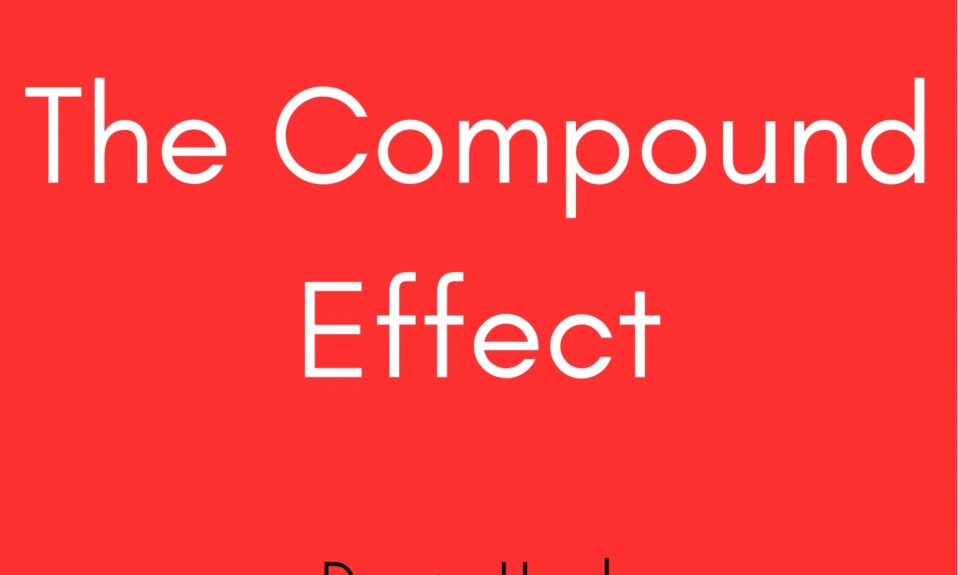
Plot Summary
The compound effect summary by Darren Hardy learnt the value of hard work from his father, a strict disciplinarian who assigned duties and expected good grades at school. By his mid-20s, Hardy had built a corporation worth $50 million in revenue. While looking for strategies to boost behavior, he came across the principles stated in The Compound Effect.
Hardy’s Compound Effect principle (See: Index of Terms) is based on doing simple, positive things continuously until success begins to compound itself. Foregoing a single 125-calorie treat every day for 31 months results in a 33-pound weight loss. Adding the same number of calories over the same time period will have the opposite effect, which can have long-term detrimental consequences. In either case, the results begin slowly but quickly compound into a substantially positive—or negative—result.
This idea applies to every activity, good or bad. Overspending can lead to bankruptcy, but limiting unnecessary purchases will result in significant savings over time. Slight modifications in various areas can transform a life: Removing one Coke per day from a diet, reducing a few minor purchases every month, and starting an exercise routine with a one-mile walk can result in a new person after a year.
Improvements in one area frequently have repercussions that spread to other areas. Weight loss, for example, boosts energy and improves attitude, resulting in better health, better work performance, and stronger family ties.
When people embrace complete responsibility for their own lives and stop blaming circumstances or others for their issues, they make tremendous progress toward success. Keeping a notebook that tracks spending patterns, calorie consumption, or any other behavior that isn’t operating well might help you become more aware of the unconscious poor decisions you make. This sort of journaling provides insights that lead to improved habits.
To alter habits, the book suggests that you first identify the habits that help you, then notice those that hinder you, and last establish a set of new habits that will move you closer to your ultimate goal. Then, identify what most inspires you in life and use that as “why-power” to fuel your motivation to change. Finally, start slowly and deliberately changing your habits by writing down your goals, removing things that trigger bad habits, replacing old behaviors with similar-but-better ones—carrots and celery, for example, instead of potato chips—and using the law of attraction to manifest good habits by visualizing them.
Hardy contends that it can be difficult to establish a habit, but once established, it capitalizes on momentum and will continue indefinitely as long as we provide a modest amount of maintenance energy each day. Setting up routines based on new habits is one method to maintain momentum. This embeds the habits inside standardized, automated behaviors, making the habits automatic as well.
External factors such as the media, acquaintances, and surroundings can all have an impact on our attitudes. The media often captures our attention with disturbing reports that have a negative impact on our attitudes; it is ideal to limit media exposure to material that is individually useful, informative, and inspirational. Friends and companions, on the other hand, tend to tug our conduct toward theirs, so choosing people who best represent our own aims and limiting our interactions with those who do not share those values can significantly increase our chances of success. If we allow clutter or anything else in our environment that interferes with our goals, we will remain trapped at that level.
Every life contains “moments of truth” that push us to perform our best. Meeting and exceeding those obstacles allows a person to accelerate their growth. Going the additional mile for customers, friends, and family will not only add to a person’s accomplishments; it will double them.
Hardy closes by arguing that the best way to achieve success is to help others achieve it for themselves.
Introduction: Chapter 1 Analysis
The book’s introductory paragraphs present the premise that tiny improvements, when performed consistently, result in significant benefits. This notion underpins all that follows.
Hardy talks about his role as “the central curator of the success media industry” (xii). This primarily pertains to his eight years as the publisher of Success magazine. Hardy considers himself an authority in the personal-improvement sector, and his books have been bestsellers, with The Compound Effect selling over a million copies. None of this guarantees that Hardy’s system will work for everyone; readers must determine whether it is suitable for them.
Hardy’s Compound Effect reshapes the concept of hard effort into modest, deliberate, positive steps made consistently. Instead of victory via tiredness, Hardy investigates how to attain success through consistency.
The Compound Effect is based on the idea of compound interest: a regular, tiny sum saved at interest over years and years gradually accumulates until it becomes a very enormous stack of money. Compounding works slowly, but the sum accumulates faster and faster, multiplying its interest rate onto the earnings from previous interest payments, until the few hundred dollars of earnings in the first year become tens of thousands of dollars of earnings many years later on a basis of hundreds of thousands or more.
Making the improvements that establish a slow-and-steady rate of growth involves a set of abilities detailed in the book’s next chapters. Hardy is a stickler for detail, and he educates readers like a personal trainer, encouraging them to resist the temptation to slack off and do the hard thing. The book’s technique has the advantage of making the difficult task appear relatively simple when carried out properly.
The remainder of the book contains practical ways for improving the effectiveness of our behaviors.
Chapter 2 Analysis.
In Chapter 2, Hardy takes a deep dive into the substance of his system. The chapter focuses on two skills: accepting responsibility for one’s actions and keeping notebooks that monitor troublesome habits in order to improve them.
Hardy investigates how to create the habit of hard work. Blaming the world for one’s difficulties is one of the most detrimental mindsets. blaming others, fate, or bad luck is an attempt to exonerate oneself or avoid making an effort. This holds no power. Instead, Hardy proposes that we take full responsibility for any condition we find ourselves in and then strive hard to improve it. This is not an attempt to criticize ourselves, but rather to highlight areas where we might improve by our own efforts.
Hardy isn’t implying that others aren’t accountable for their role in the success or failure of a collaborative effort. He is implying that everyone of us is solely responsible for the results we seek. Other people in our lives bear similar responsibility for the outcomes they seek. People frequently collaborate to achieve goals, but if one of the parties fails to fulfill their commitments, it just indicates that they have lost alignment. If possible, the team negotiates a realignment, repairs the damage, and then moves forward. If not, the remaining team members are accountable for identifying alternate methods and/or individuals to meet their objectives.
Sometimes others are tough, there is bad weather, our flight is canceled, or we are injured. Our job is to find solutions to these difficulties. If it’s too late—our spouse quits, we’re fired, the sale falls through, we break a bone, or get sick—we assess our mistakes, make changes, and move forward to swiftly heal any harm.
Sometimes we feel responsible for the well-being of others with whom we work closely. This does not oblige people to feel similarly toward us. If we insist on other team members sharing our motivations, we become caught up in trying to dominate or force them to obey. This is a type of blaming others for our failure to meet our own objectives. It serves as a pretext to complain while also causing resentment and stress. When we let go of the need to control, we can focus on the power of being accountable for our intended outcomes.
Hardy describes a technique for developing improvements called “tracking.” This is keeping a log of a certain activity—for example, writing down every calorie consumed, dollar spent, or mile walked—and detecting negative or positive tendencies in our behavior and making relevant adjustments. This system predicts and corrects possible problems before they occur, and it promptly resolves any existing issues. When we take control of our behaviors, we accept responsibility for the outcomes.
This does not give others the right to treat us unfairly. If they misbehave, it is our job to take steps to resolve the dispute or locate people with whom we can work happily. The responsibility for achieving the desired results is always ours. That approach opens up many opportunities that would otherwise go unnoticed if we blamed others.
Chapter 3 Analysis
Chapter 3 goes into detail about how to form and sustain excellent habits. Though such behaviors can improve our health and well-being in a variety of ways—losing weight, exercising, spending less—the chapter is primarily concerned with improving our performance in competitive situations such as work, sales, sports, romance, or any other area in which we achieve our goals by outperforming our opponents.
In Chapter 3, Hardy delves more into the habit of hard work. He describes the chapter as “choosing to make up for what you lack in innate ability with discipline, hard work, and good habits” (54). This implies that a person can overcome a lack of native talent via consistent efforts to improve. It also implies that one can outperform competition through mere effort, provided that effort is based on regular habits that improve performance.
Success, especially against fierce competition, necessitates a dedication to working long hours. Hardy emphasizes a key benefit of putting in extra effort: “[If change were easy, and everyone was doing it, it would be much more difficult for you and me to stand out and become extraordinary success” (87-88).
Hardy’s strategy to summoning the necessary energy is “why-power,” which is defined as an exciting desire or goal that motivates a person to go the extra mile to attain it. Hardy claims that “when the reason is big enough, you will be willing to perform almost any how” (60). This paraphrases an adage by 19th-century German existentialist philosopher Friedrich Nietzsche, who declared: “If you have your why? for life, then you can get along with almost any how?” (Nietzsche, Friedrich; Twilight of the Idols. Duncan Large translated it for Oxford University Press in 2008. Hardy’s concept is not new, but he has adapted it to help readers navigate the ups and downs of the road to success.
Hardy maintains that true “why-power” stems not from a desire for money or fame, but from undertakings that meet our deepest desires. Only these can sustain our efforts when times are bad or money isn’t flowing. One criteria is to consider whether you would want to undertake the work even if you didn’t need the money. Another excellent clue is that you can’t imagine not doing it.
Hardy delves into another essential theme, The Importance of a Positive Outlook. He discusses the “Law of Attraction” (66), a prominent concept in the self-help genre. According to the Law of Attraction, when you think about something, it begins to manifest in your life. Most books on positive visualization claim that our thoughts truly produce the objects we imagine, but Hardy’s argument is more concise: He believes that those things have always been around us, and that we only notice them when we think about them. For him, it’s the observing that matters: When we think about what we want, we start to see it in the world, which means we’re already halfway there.
Chapter 4 Analysis
Hardy uses the term “momentum” to describe the power of habitual consistency, and this chapter digs into how to build the energy required for onward motion. Hardy revisits the book’s main theme, Success Through Consistency. In some ways, this chapter builds on Chapter 1 by providing examples of how constancy leads to big results. It compares forward motion to machines that consume a lot of energy to get up to speed but then require very little input to keep going.
Self-help books present concepts about how changes in attitudes lead to better life outcomes. The majority of the data presented by self-help authors is based on insights and common sense. Some authors use science to back up their opinions. Authors reinforce their claims with the rhetorical strategy of a “appeal to authority” by linking science to their self-improvement notions.
Such an appeal is formally regarded as a fallacy: just because a person or thought is highly accepted does not imply that it is accurate, and linking that idea to another idea does not demonstrate the latter. Deepak Chopra utilized quantum mechanics in Quantum Healing (2015) to support his claim that humans can change their own physiologies through thought. Chopra suggested that because subatomic particles’ locations and energies are unknown, humans can use their imaginations to slow or reverse physical aging. Scientists squawked in outrage, pointing out that the Uncertainty Principle does not apply at the scale of the human body.
Hardy, too, appeals to rigorous science, but he does so with humor. He brings up Newton’s Law of Inertia, which states that physical objects keep their momentum unless they are acted upon. He elaborates: “Put another way, couch potatoes tend to stay couch potatoes” (92).
Hardy also employs the comparison of a railroad steam engine, which generates momentum by applying force continuously until it is rushing down the rails at a high speed. Much like a train needs expend a lot of energy to obtain its travel speed, people must exert a lot of psychological effort to get the “momentum” of strong forward motion with new habits. Like a locomotive, once we’re “up to speed” on a new activity, we need significantly less energy to sustain that “speed.”
Hardy compares psychological and physical inertia and momentum to encourage readers to make greater efforts in their own lives. He hopes to introduce readers to ideas about psychological momentum and how to use it.
According to Hardy, one way to stay on track with one’s life is to routinely practice pleasant wake-up and late-night routines. He describes his own practices to demonstrate how habits, when incorporated in routines, can maintain consistently positive attitudes. His idea is that people can start and end their days in ways that assist them cope with whatever life throws at them. An entire day does not have to be equally punctilious: “The rest of the day can take a million different shapes” (102).
By incorporating new habits into our routines, we no longer have to rely on our willpower to achieve tasks. Instead, positive habits develop naturally, and our forward momentum continues with little effort. This is the main point of the chapter.
Chapter 5: Analysis
Chapter 5 investigates the external factors that can aid or impede progress toward our objectives. Hardy focuses on three forces: media, acquaintances, and environment. One’s interaction with them necessitates ongoing attention.
The media entices us with news of worrisome events. Most of the time, these have little to do with our personal life, but it’s difficult to tell the difference between significant bad news and news that is simply luridly intriguing. People enjoy stories, but a constant assault of disaster stories—a conflict halfway around the world, a raging forest fire 1,000 miles away, a horrific bus accident in a faraway country—can drastically damper our spirits, even if they are remote from us.
In the present era, what happens elsewhere can have an impact on everyone on the planet. However, this just complicates the challenge of distinguishing between threats that must be addressed and those that do not concern us.
Acquaintances might also have an adverse influence. Hardy quotes Jim Rohn, an American entrepreneur, who famously stated that we are the average of the five individuals with whom we most associate. As a result, we must exercise caution when selecting those five individuals. When we recognize that a friend behaves or thinks in ways that do not align with our goals, we must navigate the difficult task of leaving their company. They are likely to want to continue the relationship and will resist our decision.
One of Hardy’s remedies is to simply limit the amount of time spent with specific people. Those with whom you can have a pleasant contact for three minutes, or even three hours, may not be suitable company for three days or three weeks. A variation on this is to identify the characteristics or hobbies you share with someone and devote your time to those things. You may not want to go barhopping with a specific person, but you can have enjoyable chats with them about issues of mutual interest. In these ways, we may manage our friendships such that our interactions represent the best of both ourselves and others.
A critic would argue that if a person is the average of their five closest colleagues, shifting to a new and better group of five will tend to lower that group’s average due to your lower impact. Hardy might respond that the group pulls you up to their level, where your unique contributions may elevate the group’s level even higher.
Hardy also discusses the importance of having a positive outlook. This is a frequent concept in self-help literature and The Compound Effect. According to Hardy, “you will get in life what you accept and expect you are worthy of” (136). Our beliefs limit what we believe we can accomplish, and we will not go any further than they allow.
Chapter 6: Conclusion Analysis
Chapter 6 is about exceeding people’ expectations. Hardy claims that this produces a significantly greater multiplier effect than the modest amount of additional work required. This occurs most frequently in situations involving contact with others: the extra effort results in a “WOW” response that can seal a sale, contribute to a sporting victory, produce recognition, or win a spouse.
Putting in a little more work than planned is similar to making a tiny additional payment on your mortgage each month: the principal is paid down considerably faster, and you own your home years sooner. Going the additional mile for others increases the results since recipients appreciate the extra effort and will return for more of the same. This significantly increases client retention; at home and with friends, it fosters grateful loyalty.
Hardy’s attitude is not only to work harder, but also to work smarter. His advise is intended to simplify and enhance effort, resulting in significantly higher production. Small, good adjustments replace some labor with more effective efforts. Finding “why-power” is intended to invigorate and excite us, making hard labor enjoyable rather than a burden. Hardy thinks that improving our inputs, friendships, and environment makes our life easier. Making an extra effort shifts the balance decisively in our favor.
Hardy’s advice is to replace ineffective efforts with those that, over time, offer far superior results. In short, The Compound Effect is intended to be a system for accomplishing difficult tasks in a simple way.



